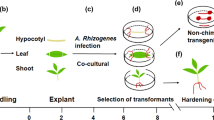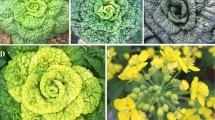Abstract
Actinidia arguta and related species produce small edible kiwifruit (kiwiberry) with attractive consumer features and high nutritional value. As a recently developed crop, kiwiberry can be improved further by classical breeding or genetic manipulation. The currently available Agrobacterium-mediated transformation protocol is only applicable to a limited number of kiwiberry genotypes such as the female cultivar ‘Hortgem Tahi’. We developed protocols for regeneration and Agrobacterium-mediated transformation of two A. arguta genotypes, female AA06-01 and male AA05-06, also applicable to ‘Hortgem Tahi’. Altered composition of basal salts in the callus-induction media was sufficient to prevent callus browning in AA06-01 and ‘Hortgem Tahi’, but not in AA05-06. Altering the hormone composition to avoid a prolonged callus stage was successfully used to prevent browning and induce shoot development in all three genotypes. Using our improved protocols, Agrobacterium-mediated transformation of a binary vector carrying the neomycin phosphotransferase II (nptII) expression cassette gave rise to kanamycin-resistant plants of both AA06-01 and AA05-06 and the presence of the nptII transgene was confirmed by genomic PCR. The improved protocols were also used to ectopically overexpress the anthocyanin-related transcription factor AcMYB110 in ‘Hortgem Tahi’ giving rise to purple callus with elevated anthocyanin accumulation. AcMYB110 expression and increased levels of anthocyanins were detected in mature leaves of established transgenic plants compared to controls, clearly demonstrating the important role for MYB110 in regulation of anthocyanin accumulation in kiwiberry. The protocols developed during this study provide tools for further functional analyses and genetic manipulation of kiwiberry genotypes.
Key message
Using a newly developed transformation method we were able to generate transgenic lines of three Actinidia arguta genotypes and demonstrate an important role for MYB110 in anthocyanin accumulation in kiwiberry.





Similar content being viewed by others
References
An J-P, Qu F-J, Yao J-F, Wang X-N, You C-X, Wang X-F, Hao Y-J (2017) The bZIP transcription factor MdHY5 regulates anthocyanin accumulation and nitrate assimilation in apple. Hortic Res 4:17023
Bai C, Rivera SM, Medina V, Alves R, Vilaprinyo E, Sorribas A, Canela R, Capell T, Sandmann G, Christou P (2014) An in vitro system for the rapid functional characterization of genes involved in carotenoid biosynthesis and accumulation. Plant J 77:464–475
Chung S-M, Vaidya M, Tzfira T (2006) Agrobacterium is not alone: gene transfer to plants by viruses and other bacteria. Trends Plant Sci 11:1–4
Comeskey DJ, Montefiori M, Edwards PJB, McGhie TK (2009) Isolation and structural identification of the anthocyanin components of red kiwifruit. J Agric Food Chem 57:2035–2039
Condliffe PC, Davey MR, Brian Power J, Koehorst-van Putten H, Visser PB (2003) An optimised protocol for rose transformation applicable to different cultivars. In: XXI international eucarpia symposium on classical versus molecular breeding of ornamentals-Part I 612, pp 115–120
Crowhurst RN, Gleave AP, MacRae EA, Ampomah-Dwamena C, Atkinson RG, Beuning LL, Bulley SM, Chagne D, Marsh KB, Matich AJ (2008) Analysis of expressed sequence tags from Actinidia: applications of a cross species EST database for gene discovery in the areas of flavor, health, color and ripening. BMC Genom 9:351
Daigen M, Kawakami O, Nagasawa Y (2000) Efficient anther culture method of the japonica rice cultivar Koshihikari. Breed Sci 50:197–202
Fraser LG, Seal AG, Montefiori M, McGhie TK, Tsang GK, Datson PM, Hilario E, Marsh HE, Dunn JK, Hellens RP (2013) An R2R3 MYB transcription factor determines red petal colour in an Actinidia (kiwifruit) hybrid population. BMC Genom 14:28
Gould KS (2004) Nature's Swiss army knife: the diverse protective roles of anthocyanins in leaves. Biomed Res Int 2004:314–320
Han M, Gleave AP, Wang T (2010) Efficient transformation of Actinidia arguta by reducing the strength of basal salts in the medium to alleviate callus browning. Plant Biotechnol Rep 4:129–138
Hellens RP, Allan AC, Friel EN, Bolitho K, Grafton K, Templeton MD, Karunairetnam S, Gleave AP, Laing WA (2005) Transient expression vectors for functional genomics, quantification of promoter activity and RNA silencing in plants. Plant Methods 1:13
Hood EE, Gelvin SB, Melchers LS, Hoekema A (1993) New Agrobacterium helper plasmids for gene transfer to plants. Transgenic Res 2:208–218
Irshad M, Debnath B, Mitra S, Arafat Y, Li M, Sun Y, Qiu D (2018) Accumulation of anthocyanin in callus cultures of red-pod okra [Abelmoschus esculentus (L.) Hongjiao] in response to light and nitrogen levels. Plant Cell Tissue Org Cult 134:29–39
Janssen B-J, Gardner RC (1993) The use of transient GUS expression to develop an Agrobacterium-mediated gene transfer system for kiwifruit. Plant Cell Rep 13:28–31
Latocha P (2017) The nutritional and health benefits of kiwiberry (Actinidia arguta): a review. Plant Foods Hum Nutr 72:325–334
Liu Y, Liu J, Qi Y, Zhang A, Liu Z, Ren X (2019) Identification and characterization of AcUFGT6b, a xylosyltransferase involved in anthocyanin modification in red-fleshed kiwifruit (Actinidia chinensis). Plant Cell Tissue Org Cult 138:257–271
Montefiori M, Comeskey DJ, Wohlers M, McGhie TK (2009) Characterization and quantification of anthocyanins in red kiwifruit (Actinidia spp.). J Agric Food Chem 57:6856–6861
Montefiori M, Espley RV, Stevenson D, Cooney J, Datson PM, Saiz A, Atkinson RG, Hellens RP, Allan AC (2011) Identification and characterisation of F3GT1 and F3GGT1, two glycosyltransferases responsible for anthocyanin biosynthesis in red-fleshed kiwifruit (Actinidia chinensis). Plant J 65:106–118
Murashige T, Skoog F (1962) A revised medium for rapid growth and bio assays with tobacco tissue cultures. Physiol Plant 15:473–497
Peng Y, Lin-Wang K, Cooney JM, Wang T, Espley RV, Allan AC (2019) Differential regulation of the anthocyanin profile in purple kiwifruit (Actinidia species). Hortic Res 6:3
Shang Y, Schwinn KE, Bennett MJ, Hunter DA, Waugh TL, Pathirana NN, Brummell DA, Jameson PE, Davies KM (2007) Methods for transient assay of gene function in floral tissues. Plant Methods 3:1
Wang T, Atkinson R, Janssen B (2007) Choice of Agrobacterium strain for transformation of kiwifruit. Acta Hortic 753:227–232
Wang T, Karunairetnam S, Wu R, Wang Y-Y, Gleave A (2010) High efficiency transformation platforms for kiwifruit (Actinidia spp.) functional genomics. In: XXVIII international horticultural congress on science and horticulture for people (IHC2010): international symposium on 929, pp 143–148
Wang T, Ran Y, Atkinson RG, Gleave AP, Cohen D (2006) Transformation of Actinidia eriantha: a potential species for functional genomics studies in Actinidia. Plant Cell Rep 25:425
Zhang T, Xu H, Yang G, Wang N, Zhang J, Wang Y, Jiang S, Fang H, Zhang Z, Chen X (2019) Molecular mechanism of MYB111 and WRKY40 involved in anthocyanin biosynthesis in red-fleshed apple callus. Plant Cell Tissue Org Cult 139:467–478
Zheng H-Z, Wei H, Guo S-H, Yang X, Feng M-X, Jin X-Q, Fang Y-L, Zhang Z-W, Xu T-F, Meng J-F (2020) Nitrogen and phosphorus co-starvation inhibits anthocyanin synthesis in the callus of grape berry skin. Plant Cell Tissue Org Cult 142:313–325
Zheng J, An Y, Wang L (2018) 24-Epibrassinolide enhances 5-ALA-induced anthocyanin and flavonol accumulation in calli of ‘Fuji’ apple flesh. Plant Cell Tissue Org Cult 134:319–330
Acknowledgements
We thank Geeta Chhiba for media preparation, Monica Dragulescu and the glasshouse staff for management of transgenic plants and Cath Kingston for critically reading the manuscript. This work was funded by the New Zealand Ministry of Business, Innovation and Employment Grant C11X1602.
Funding
This work was funded by the NZ Ministry of Business, Innovation and Employment Grant C11X1602.
Author information
Authors and Affiliations
Contributions
DH, TW, ACA, JP and EV-G conceived and designed research. DH and YP conducted experiments and analysed data. TW contributed stock plants. DH, YP and EV-G wrote the manuscript. All authors read, edited and approved the manuscript.
Corresponding author
Ethics declarations
Conflict of interest
The authors declare that they have no conflict of interest.
Additional information
Communicated by Henryk Flachowsky.
Publisher's Note
Springer Nature remains neutral with regard to jurisdictional claims in published maps and institutional affiliations.
Electronic supplementary material
Below is the link to the electronic supplementary material.
Rights and permissions
About this article
Cite this article
Herath, D., Wang, T., Peng, Y. et al. An improved method for transformation of Actinidia arguta utilized to demonstrate a central role for MYB110 in regulating anthocyanin accumulation in kiwiberry. Plant Cell Tiss Organ Cult 143, 291–301 (2020). https://doi.org/10.1007/s11240-020-01915-1
Received:
Accepted:
Published:
Issue Date:
DOI: https://doi.org/10.1007/s11240-020-01915-1




